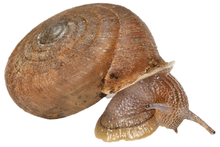| Gudeodiscus giardi | |
|---|---|

| |
| a live Gudeodiscus giardi giardi | |
| Scientific classification | |
| Domain: | Eukaryota |
| Kingdom: | Animalia |
| Phylum: | Mollusca |
| Class: | Gastropoda |
| Subclass: | Heterobranchia |
| Order: | Stylommatophora |
| Family: | Plectopylidae |
| Genus: | Gudeodiscus |
| Species: | G. giardi
|
| Binomial name | |
| Gudeodiscus giardi (Fischer, 1898)[1]
| |
| Synonyms[2] | |
|
Plectopylis Giardi Fischer, 1898 | |
Gudeodiscus giardi is a species of air-breathing land snail, a terrestrial pulmonate gastropod mollusk in the family Plectopylidae.
This species was described by French zoologist Pierre Marie Henri Fischer (1865-1916) (son of Paul-Henri Fischer) in 1898.
Subspecies
- Gudeodiscus giardi giardi (Fischer, 1898)
- Gudeodiscus giardi oharai Páll-Gergely, 2013[3]
- Gudeodiscus giardi szekeresi Páll-Gergely & Hunyadi, 2013[3]
The specific name giardi is in honor of French zoologist Alfred Mathieu Giard.[1] The subspecific name oharai is in honor of the collector Kenji Ohara.[3] The subspecific name szekeresi is in honor of the malacologist Miklós Szekeres.[3]
Distribution
The distribution of Gudeodiscus giardi includes Cao Bằng Province and the northern part of Lạng Sơn Province in Vietnam[2] and western Guangxi in China.[3]
The type locality of Gudeodiscus giardi giardi is "Cao-Bang".[1][2] Gudeodiscus giardi giardi lives in Vietnam and China.[3] Gudeodiscus giardi oharai lives in are north of Nanning in Western Guangxi, China.[3] Gudeodiscus giardi szekeresi live in the type locality only: Langur Reserve, 25 km southeast of Chongzuo, China.[3]
Description
The most important shell characters for identification of Gudeodiscus giardi include: high and rather sharply defined shell shape, narrow umbilicus (for the genus Gudeodiscus) and thick peristome.[2]
The size of the shell is small to large.[2] The shape of the shell is high and rather sharply defined.[2] The color of the shell is brownish, but some Chinese populations are small and yellow and translucent.[2] The sculpture is usually finely reticulated, that is resulting in a matt surface.[2] The umbilicus is deep.[2] Apertural lip, callus and apertural fold are very well-developed (callus is very much elevated).[2] Parietal wall has two lamellae.[2] The anterior lamella is usually connected to the lower plica.[2] Middle palatal plicae are short, depressed Z-shaped, or almost vertical, sometimes connected to each other.[2] The width of the shell 13.5–21.3 mm.[2] The height of the shell is 7.0–12.1 mm.[2]
The radula of Gudeodiscus giardi has 12 lateral teeth and 15 marginal teeth.[2] The size of the central tooth is as large as the ectocone of the first lateral.[2] The shape of the first lateral is rhomboid and pointed.[2] Marginal teeth are bicuspid or tricuspid with blunt inner cusp and shallow incision between the inner two cusps.[2]
The reproductive system of specimen from China was described by Páll-Gergely & Asami in 2014[4] and from Vietnam by Páll-Gergely et al. in 2015.[2] Embryos were not recorded in the uterus.[2] There were recorded hook-like or flat and oval calcareous granules on the internal surface of penis.[2]
Ecology
It is a ground-dwelling species as all other plectopylid snails in Vietnam.[2]
It co-occur with other plectopylids in Vietnam: with Gudeodiscus anceyi, Gudeodiscus francoisi, Sicradiscus mansuyi and with Gudeodiscus suprafilaris.[2] Gudeodiscus phlyarius live at geographically close sites to Gudeodiscus giardi.[2]
References
This article incorporates Creative Commons (CC-BY-4.0) text from the reference[2]
- ^ a b c (in French) Fischer H. (1898). "Notes sur la Faune du Haut-Tonkin V. Description d’une Espèce Nouvelle de Plectopylis". Bulletin Biologique de la France et de la Belgique 28: 310–338. pages 320–322, plate 17, figures 17–21.
- ^ a b c d e f g h i j k l m n o p q r s t u v w x y z Páll-Gergely B., Hunyadi A., Ablett J., Luong Van H., Naggs F. & Asami T. (2015). "Systematics of the family Plectopylidae in Vietnam with additional information on Chinese taxa (Gastropoda, Pulmonata, Stylommatophora)". ZooKeys 473: 1–118. doi:10.3897/zookeys.473.8659.
- ^ a b c d e f g h Páll-Gergely B. & Hunyadi A. (2013). "The family Plectopylidae Möllendorff 1898 in China (Gastropoda, Pulmonata)". Archiv für Molluskenkunde 142(1): 1-66. doi:10.1127/arch.moll/1869-0963/142/001-066.
- ^ Páll-Gergely B. & Asami T. (2014). "Additional information on the distribution, anatomy and systematics of living and fossil Chinese Plectopylidae (Gastropoda: Pulmonata)". Genus 25(3): 527–564.
